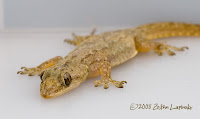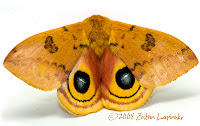 The other night I went for a walk after dark, and discovered what lurks under the lighted doorways of the buildings in the park. Surprisingly, I found little green frogs clinging to the walls under each light! I was puzzled because I didn't remember hearing that frogs were attracted to light -- or that they were able to scale vertical walls, come to think of it. And then I realized -- it wasn't the light they were attracted to, but rather they were attracted to all the insects that were attracted to the light. It was an insect buffet!
The other night I went for a walk after dark, and discovered what lurks under the lighted doorways of the buildings in the park. Surprisingly, I found little green frogs clinging to the walls under each light! I was puzzled because I didn't remember hearing that frogs were attracted to light -- or that they were able to scale vertical walls, come to think of it. And then I realized -- it wasn't the light they were attracted to, but rather they were attracted to all the insects that were attracted to the light. It was an insect buffet! Capture 1: The Green Treefrogs (Hyla cinerea) that were clinging to the wall are small frogs, no more than a couple inches long. I managed to catch one in a plastic container where he immediately became active, hopping from end to end of the container and trying to jump out. After a couple minutes of this, he finally calmed down.
Capture 1: The Green Treefrogs (Hyla cinerea) that were clinging to the wall are small frogs, no more than a couple inches long. I managed to catch one in a plastic container where he immediately became active, hopping from end to end of the container and trying to jump out. After a couple minutes of this, he finally calmed down.
 Capture 2: I went back out to see what else was lurking under the lights, and found a light colored lizard with a bright yellow belly. Lizards move very quickly and are difficult to get near, but this one was very focused on those tasty insects and I managed to grab him, too.
Capture 2: I went back out to see what else was lurking under the lights, and found a light colored lizard with a bright yellow belly. Lizards move very quickly and are difficult to get near, but this one was very focused on those tasty insects and I managed to grab him, too.
 Capture 3: I also found a very beautiful Io Moth (Automeris Io), also called a Peacock Moth. This is a large species -- this particular one is two inches wide when its wings are together. It feeds on the azaleas, in bloom now in Central Florida. The caterpillar for the Io Moth is not so nice -- it has venomous spines running down its body that will cause painful skin eruptions if handled.
Capture 3: I also found a very beautiful Io Moth (Automeris Io), also called a Peacock Moth. This is a large species -- this particular one is two inches wide when its wings are together. It feeds on the azaleas, in bloom now in Central Florida. The caterpillar for the Io Moth is not so nice -- it has venomous spines running down its body that will cause painful skin eruptions if handled.
Moths and butterflies are surprisingly easy to control when I photograph them. I put them in a translucent "studio" with the brightest light in the middle, and they go to that spot and stop. They seldom try to fly into the RV, but if they do it is not much of a problem to have a butterfly flitting around for a while, and they are easy to recapture. But lizards and frogs are another matter. They would not be willing to stay "in the light," and having them loose in the RV was not an appealing idea. So I took the two of them outside for their "shoot." They were both a bit edgy and nervous, and I was struck by the obvious increase in intelligence displayed by these two over the Lepidoptera -- they knew they might be in trouble, and they were going to try their best to escape. I took a few photos, and then let them hop and slink to freedom.
I have also started to play with light painting in a new way. Light painting is, at its simplest, using light to paint on the "canvas" of the film or digital image. I have done some simple light painting in some night astronomy photos -- you can see some in my Winter Star Party 2008 Picasa Album. For example, there is a night photo of the Orion Nebula with palm trees in the foreground, and the palm trees have been painted with red light to make them stand out from the background (white light is not permitted at star parties as it affects night vision adaptation).
 For my next light painting experiment, I decided to try using the light to paint actual words on the image. This image was taken inside my RV. Painting "light words" is truly a learning experience -- there were many, many failures before I got to the point that the writing was legible and all the letters were facing the right way! This image is now the new "My View" image for the bottom of the page.
For my next light painting experiment, I decided to try using the light to paint actual words on the image. This image was taken inside my RV. Painting "light words" is truly a learning experience -- there were many, many failures before I got to the point that the writing was legible and all the letters were facing the right way! This image is now the new "My View" image for the bottom of the page.

3 comments:
Nice discoveries.
Your lizard is a Mediterranean Gecko.
Thanks, RLO.
I thought it might be a gecko, but I couldn't find it in any books, so I felt safer just calling it a lizard. I'm grateful for the ID!
ZoAnn
Post a Comment